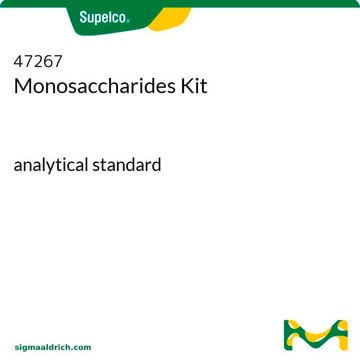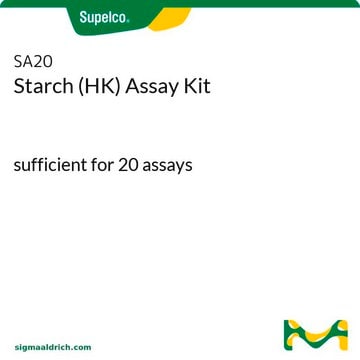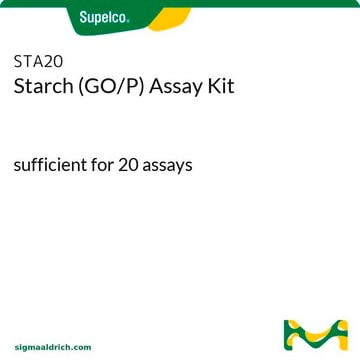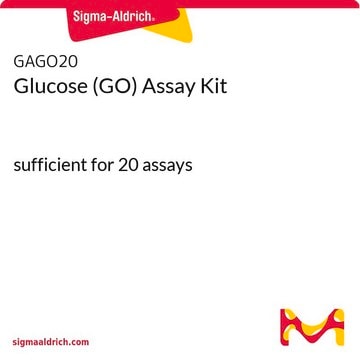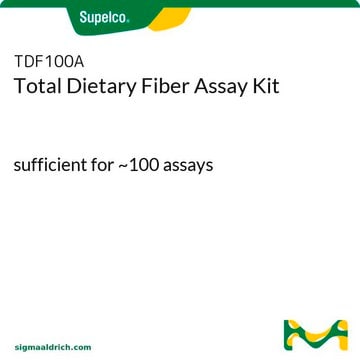Products may be shipped at a different temperature than the recommended long-term storage temperature. If the product quality is sensitive to short-term exposure to conditions other than the recommended long-term storage, it will be shipped on wet or dry-ice. If the product quality is NOT affected by short-term exposure to conditions other than the recommended long-term storage, it will be shipped at ambient temperature. As shipping routes are configured for minimum transit times, shipping at ambient temperature helps control shipping costs for our customers. For more information, please refer to the Storage and Transport Conditions document: https://www.sigmaaldrich.com/deepweb/assets/sigmaaldrich/marketing/global/documents/316/622/storage-transport-conditions-mk.pdf
MAK104
Total Carbohydrate Assay Kit
sufficient for 100 colorimetric tests
About This Item
Recommended Products
usage
sufficient for 100 colorimetric tests
application(s)
cosmetics
food and beverages
detection method
colorimetric
storage temp.
2-8°C
General description
Application
Suitability
Principle
replaced by
signalword
Danger
hcodes
Hazard Classifications
Aquatic Chronic 3 - Eye Dam. 1 - Muta. 2 - Skin Corr. 1B
Storage Class
8A - Combustible corrosive hazardous materials
Choose from one of the most recent versions:
Certificates of Analysis (COA)
Don't see the Right Version?
If you require a particular version, you can look up a specific certificate by the Lot or Batch number.
Already Own This Product?
Find documentation for the products that you have recently purchased in the Document Library.
Customers Also Viewed
-
How is shipping temperature determined? And how is it related to the product storage temperature?
1 answer-
Helpful?
-
-
How can I determine the shelf life / expiration / retest date of this product?
1 answer-
If this product has an expiration or retest date, it will be shown on the Certificate of Analysis (COA, CofA). If there is no retest or expiration date listed on the product's COA, we do not have suitable stability data to determine a shelf life. For these products, the only date on the COA will be the release date; a retest, expiration, or use-by-date will not be displayed.
For all products, we recommend handling per defined conditions as printed in our product literature and website product descriptions. We recommend that products should be routinely inspected by customers to ensure they perform as expected.
For products without retest or expiration dates, our standard warranty of 1 year from the date of shipment is applicable.
For more information, please refer to the Product Dating Information document: https://www.sigmaaldrich.com/deepweb/assets/sigmaaldrich/marketing/global/documents/449/386/product-dating-information-mk.pdfHelpful?
-
-
What are the recommended centrifuge settings and reagent mixing instructions for the MAK104 Total Carbohydrate Assay Kit? Is 2,000 x g sufficient for centrifugation?
1 answer-
As per the guidelines:
1. For sample preparation, the protocol suggests using a centrifuge speed of 12,000 RPM to ensure that all debris in the sample is properly sedimented before collecting the supernatant for the assay. While 2000 g is approximately equivalent to 4000 RPM and may be insufficient, customers can attempt this speed to see if a good pellet is obtained. However, a speed closer to 12,000 RPM is recommended. Typically, around 10,000 g for sample preparation centrifugation or a similar speed is suggested.2. The use of a horizontal or orbital shaker is suitable as long as the contents are not spilled. The goal is to gently mix the contents. Alternatively, a pipette can be used as long as it does not introduce air bubbles.
Helpful?
-
-
What are the detection sensitivity limit and the maximum concentration of carbohydrates that can be measured using the MAK104-1KT Total Carbohydrate Assay Kit?
1 answer-
According to the guidelines provided, the MAK104-1KT Total Carbohydrate Assay Kit has a lower limit of detection of 4 micrograms and an upper limit of detection of 20 micrograms.
Helpful?
-
-
Hello, I am trying to determine how to dispose of the used assays after testing. The SDS does not provide any guidance.
1 answer-
Please refer to section 13 of the SDS for information on disposal. Contact the facility and/or local EHS for further assistance.
Helpful?
-
Active Filters
Our team of scientists has experience in all areas of research including Life Science, Material Science, Chemical Synthesis, Chromatography, Analytical and many others.
Contact Technical Service

